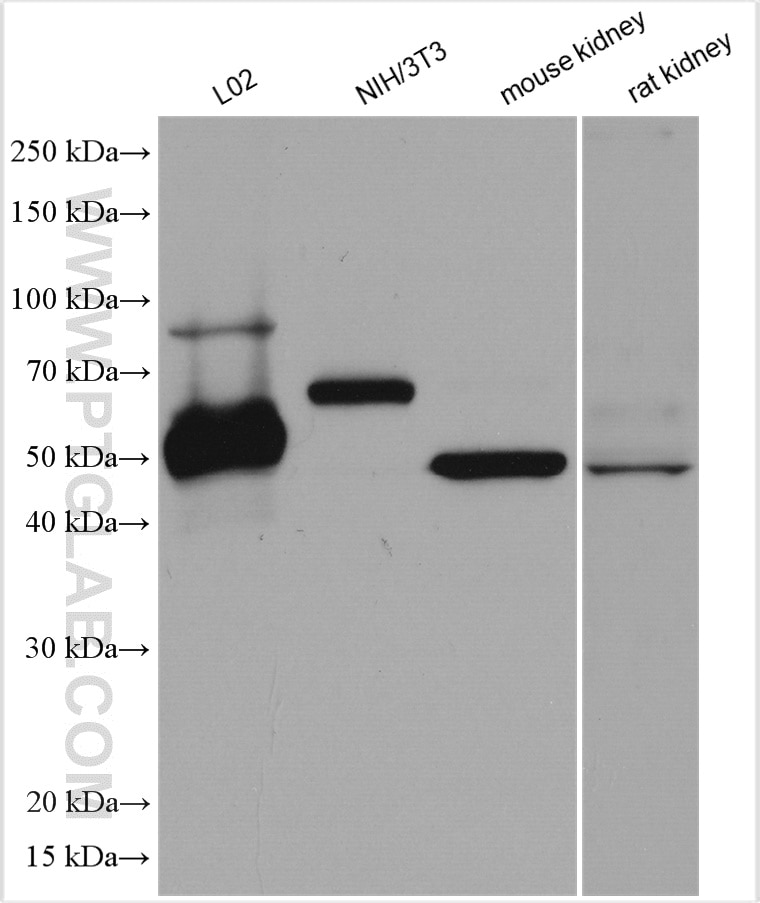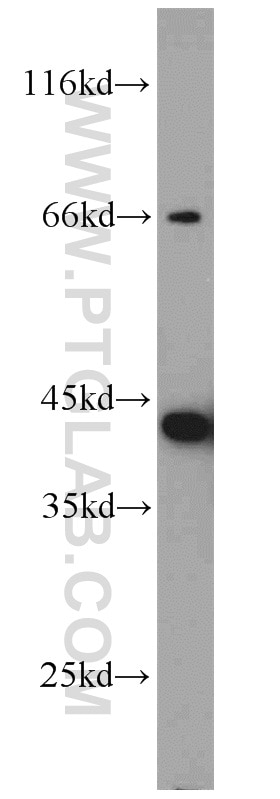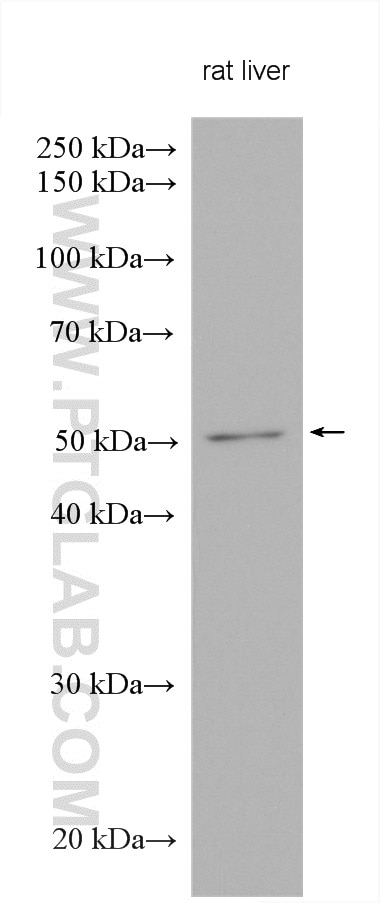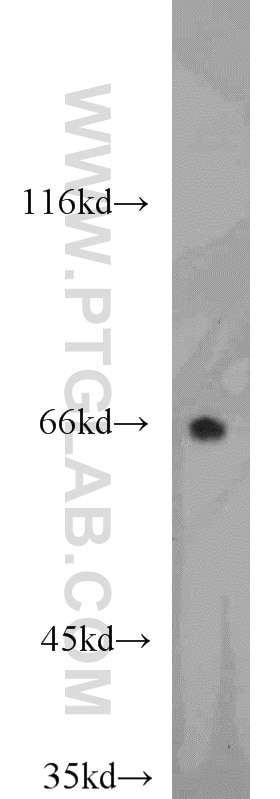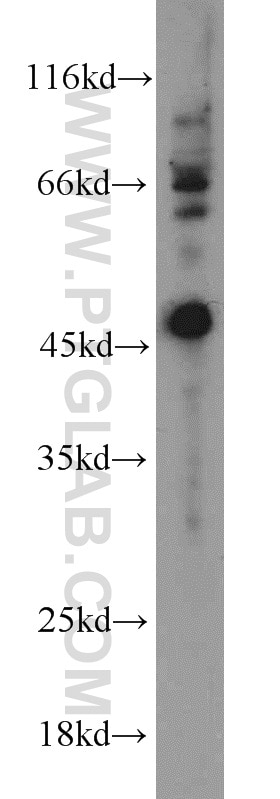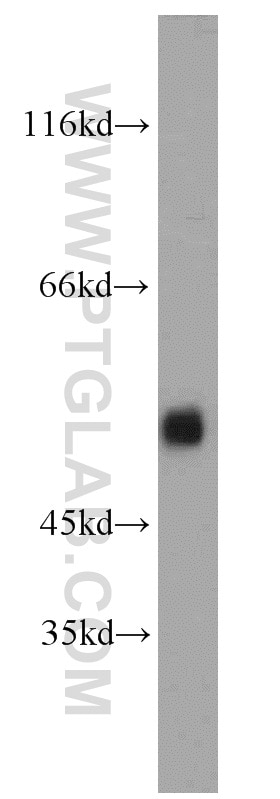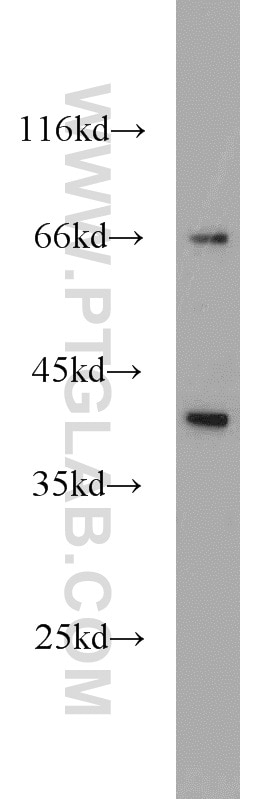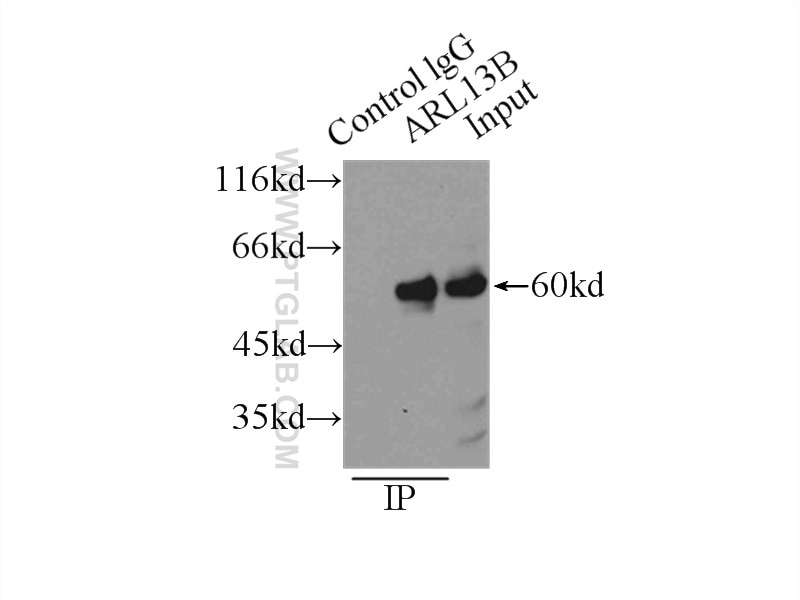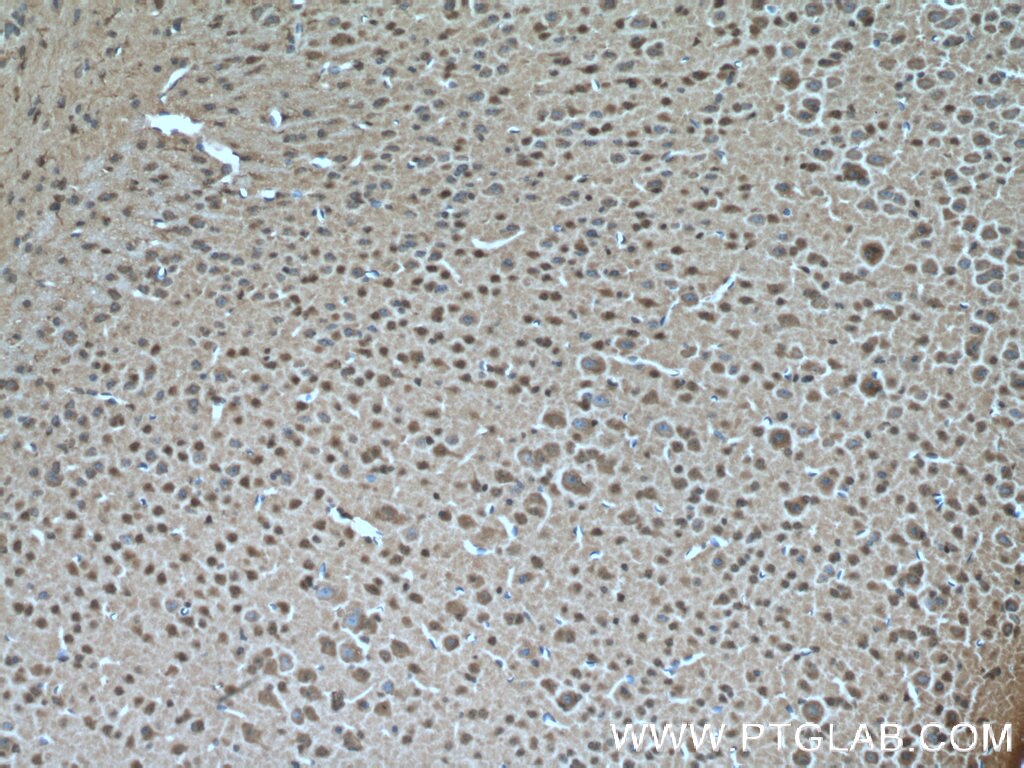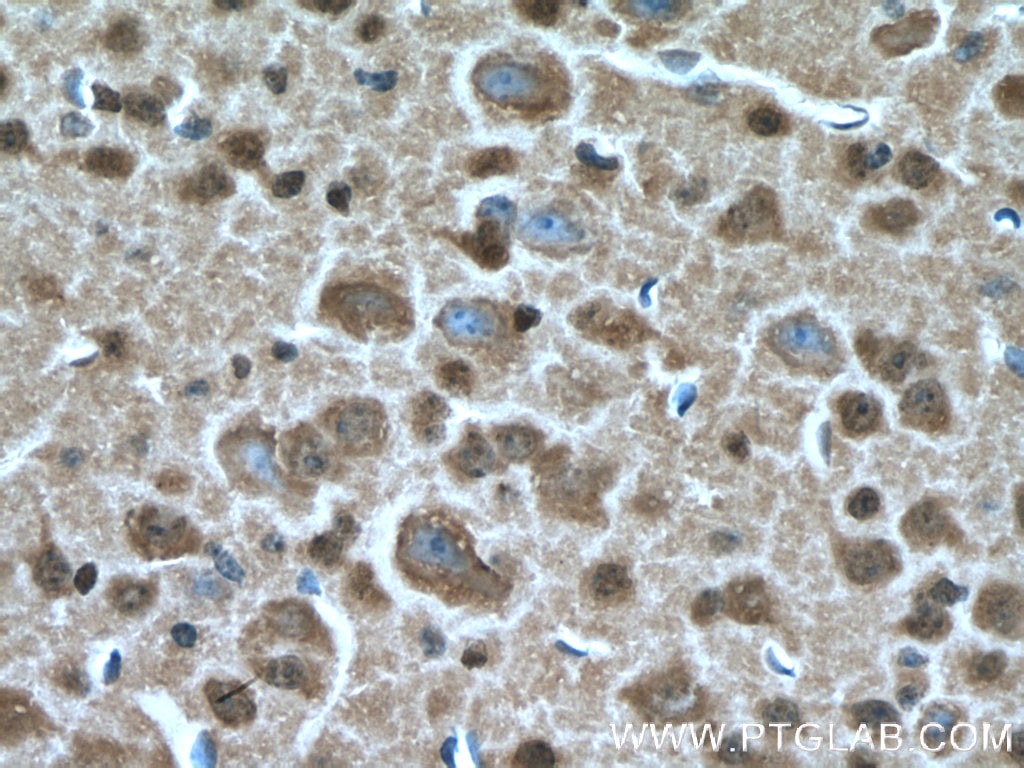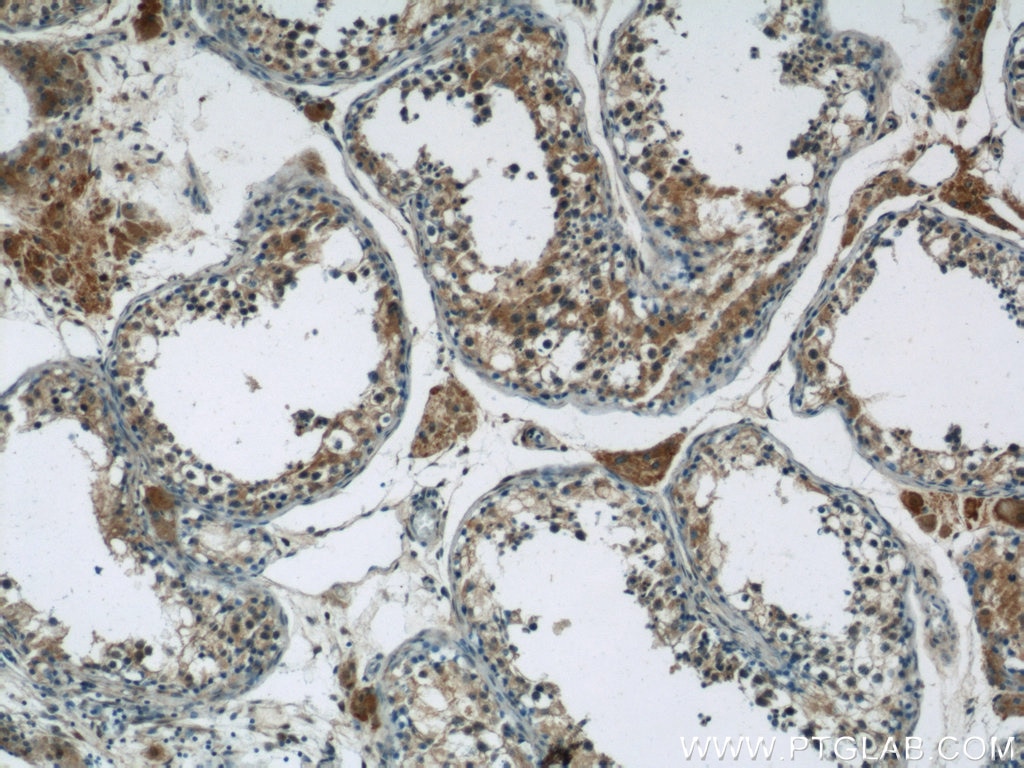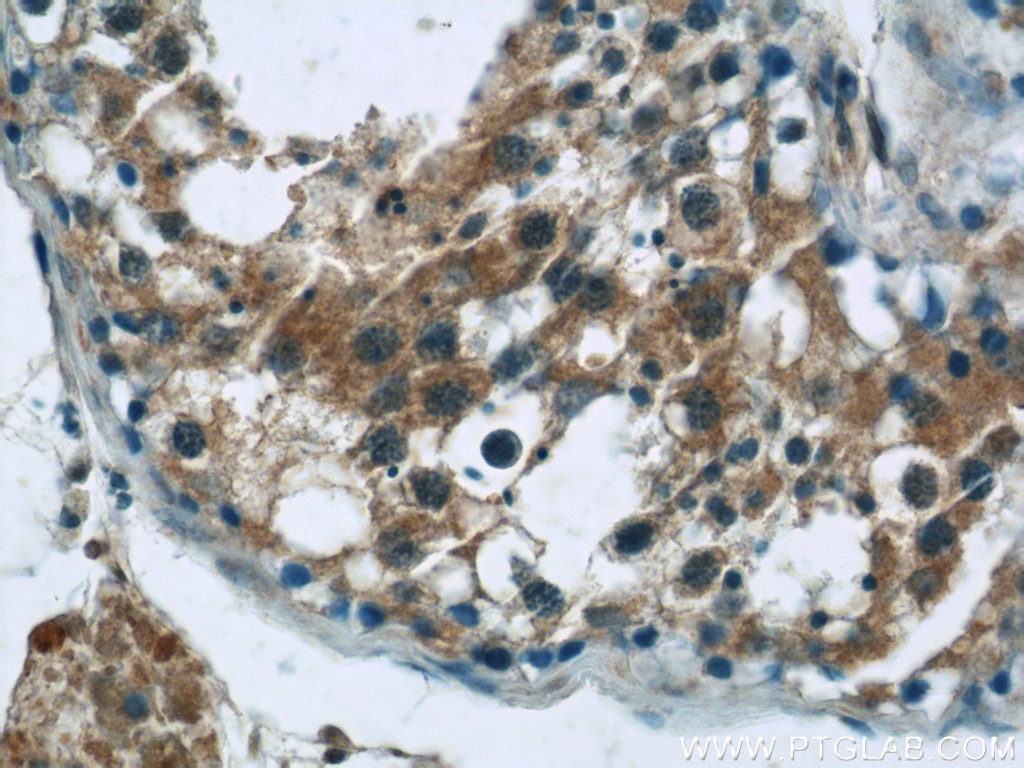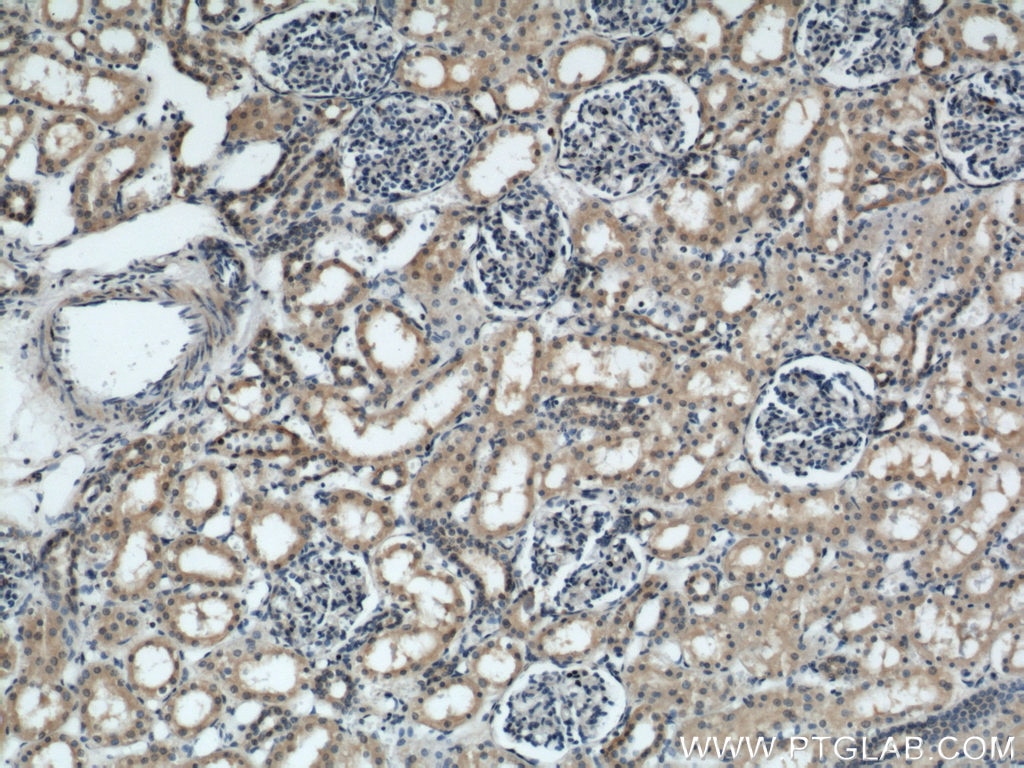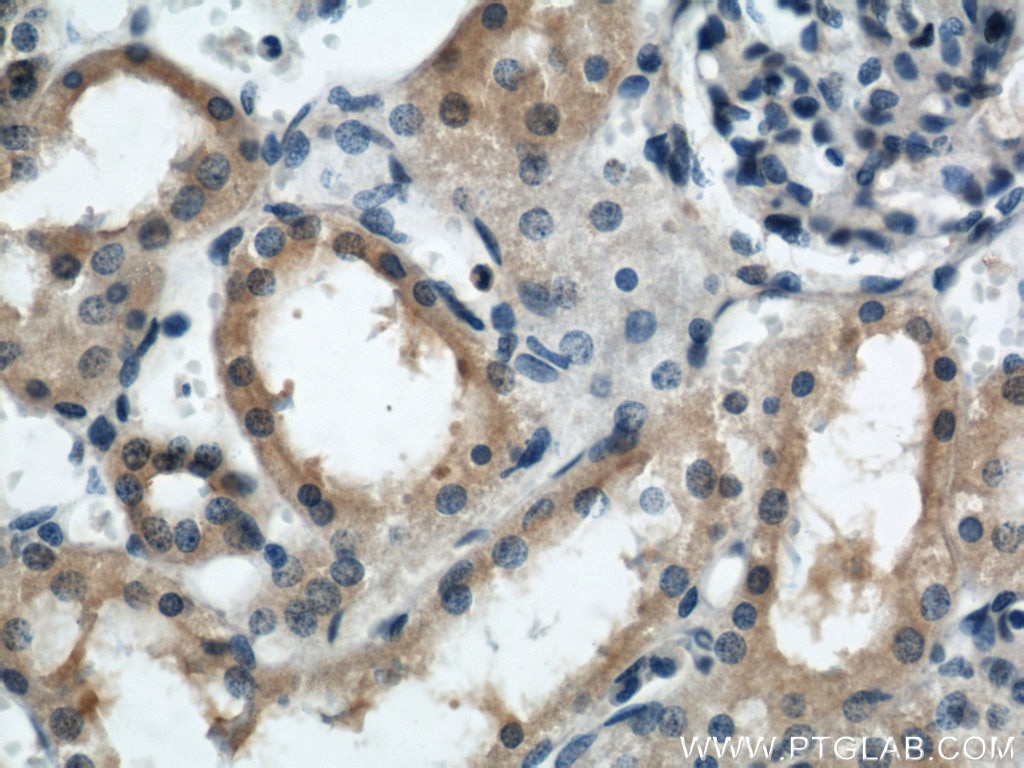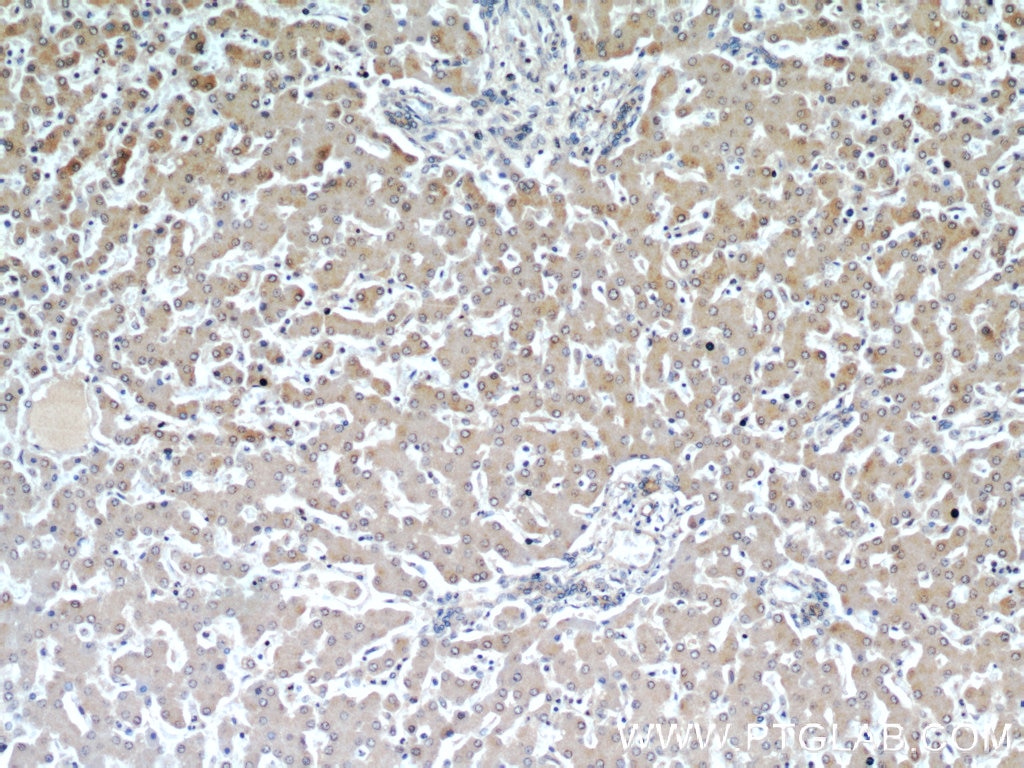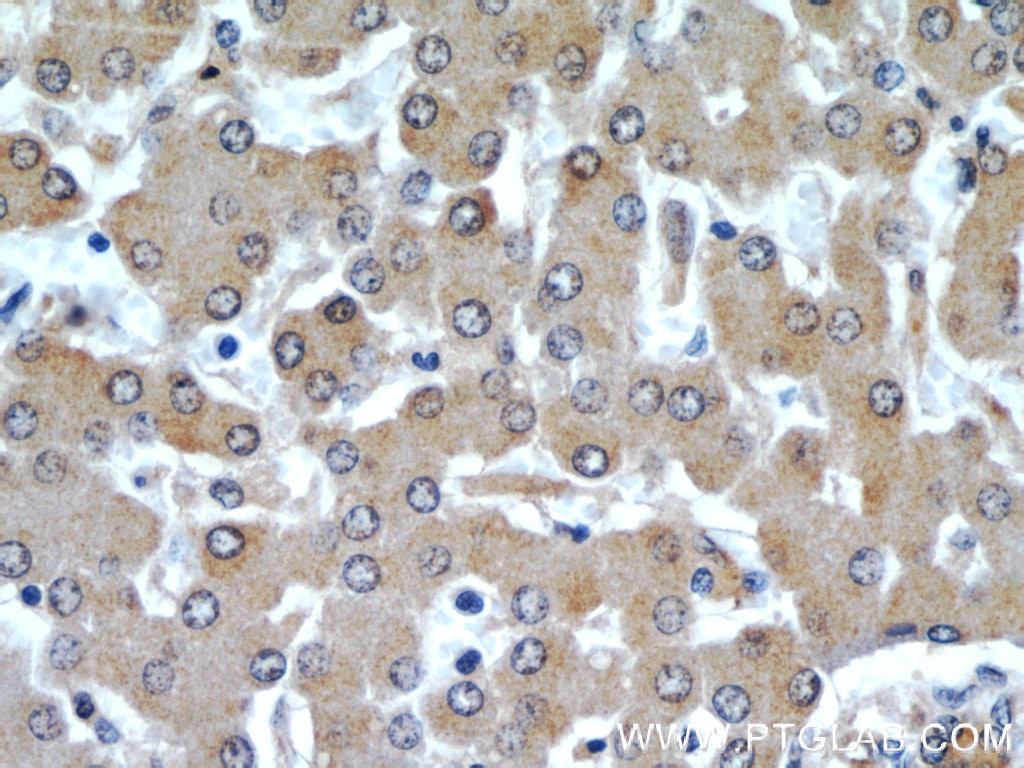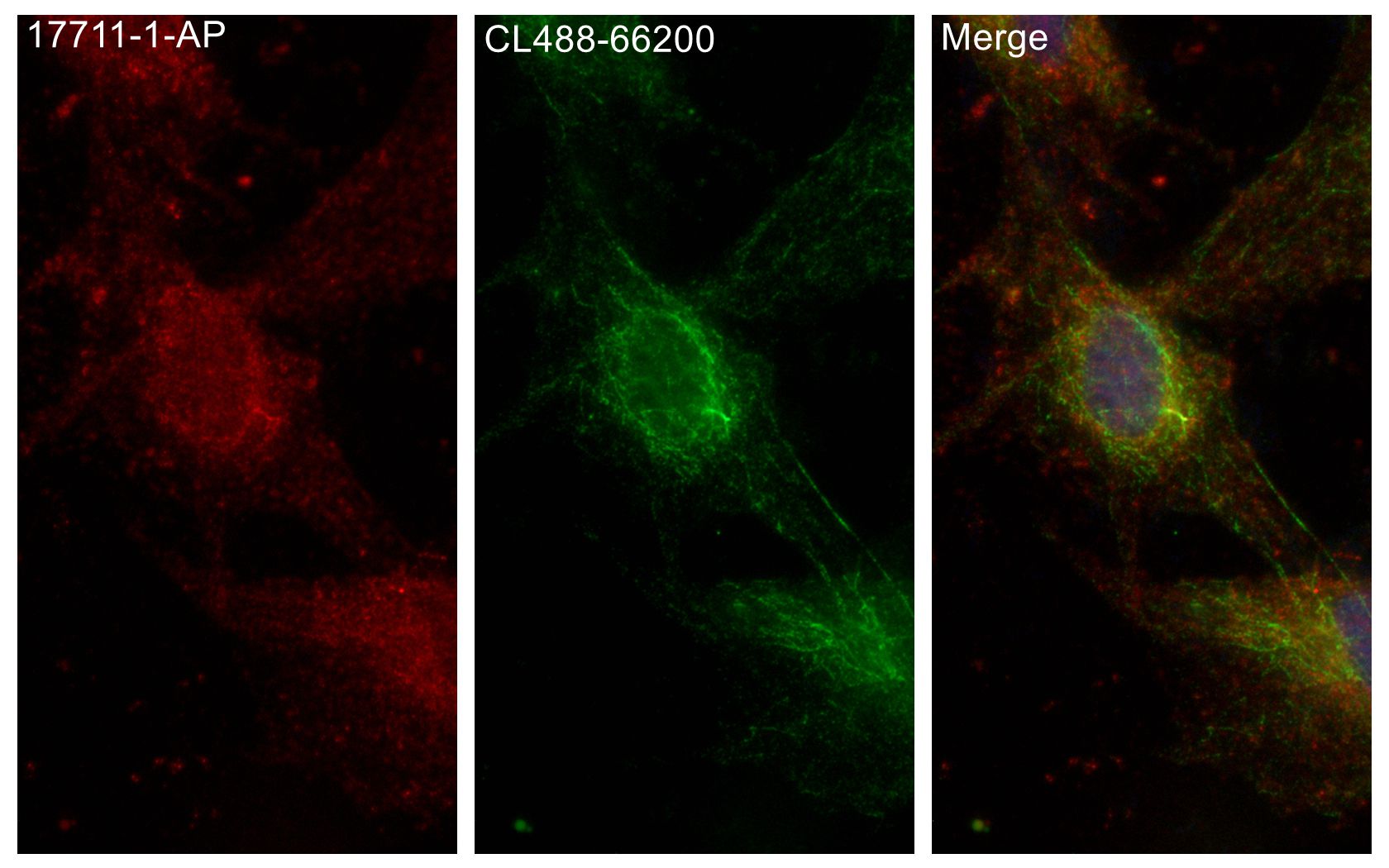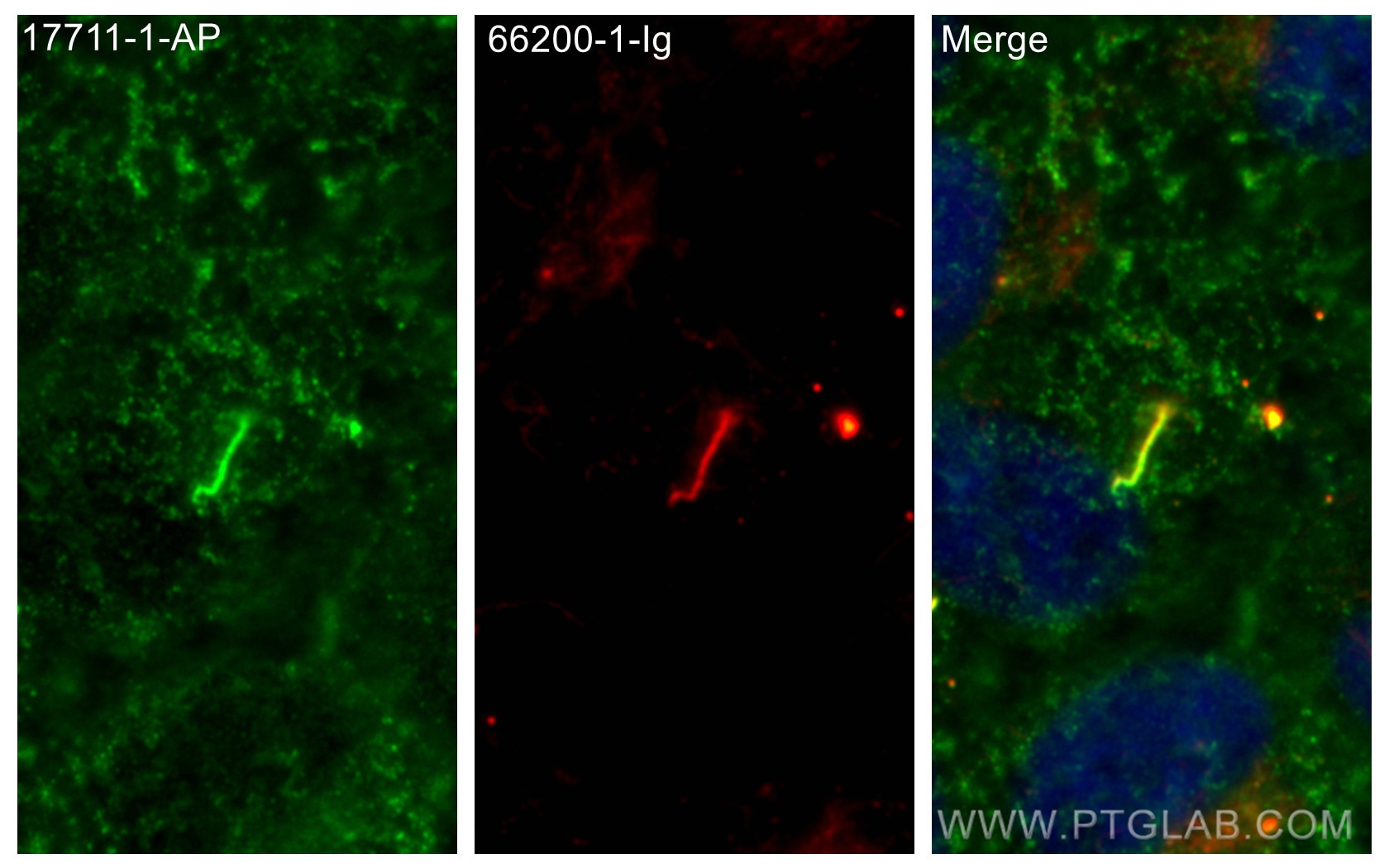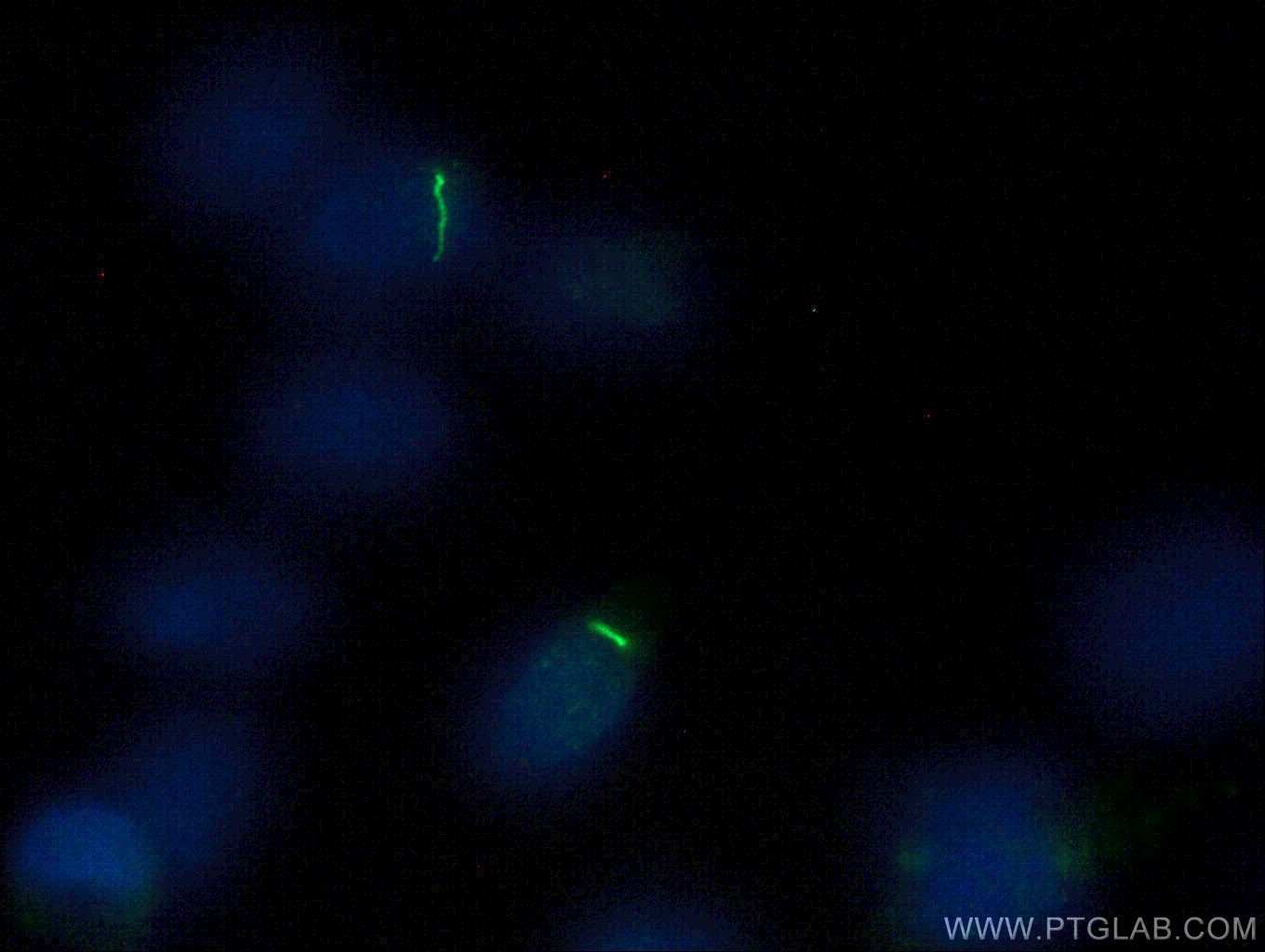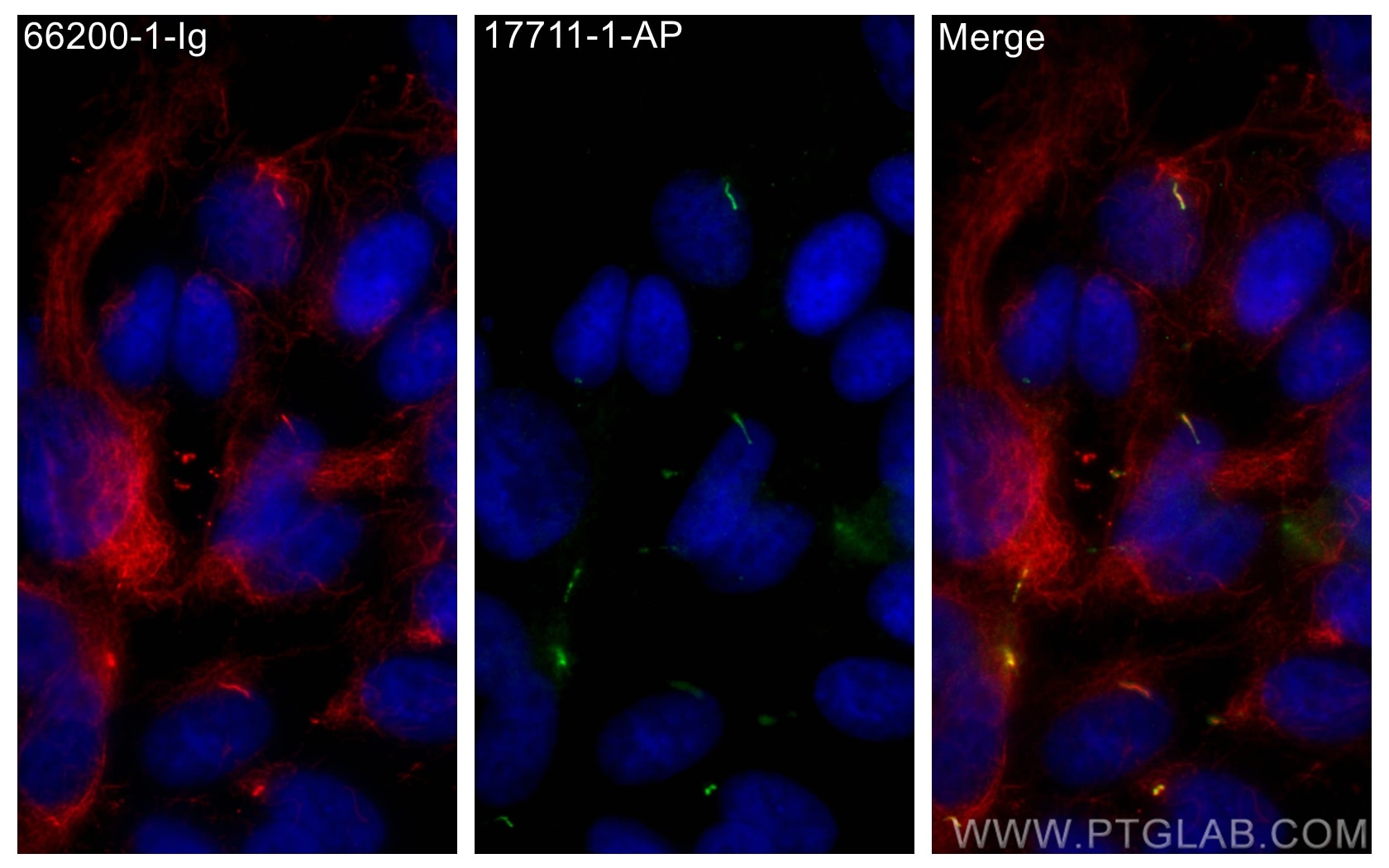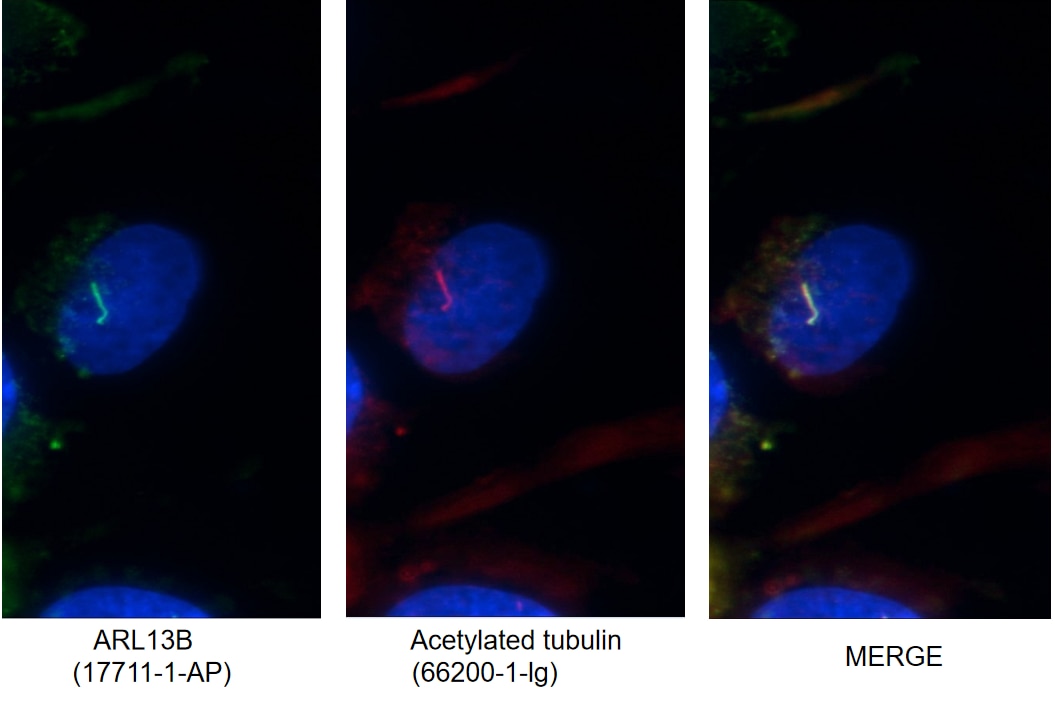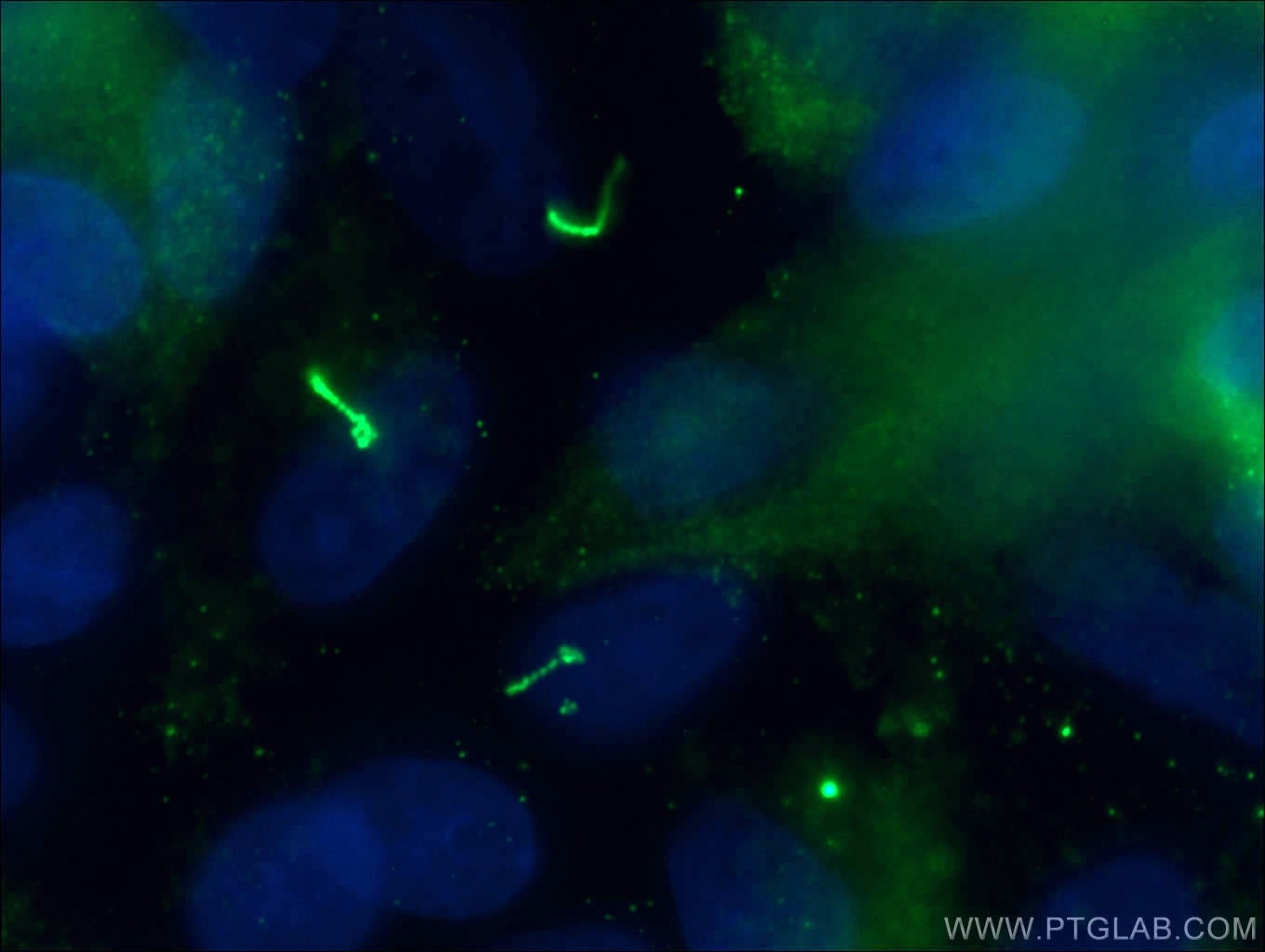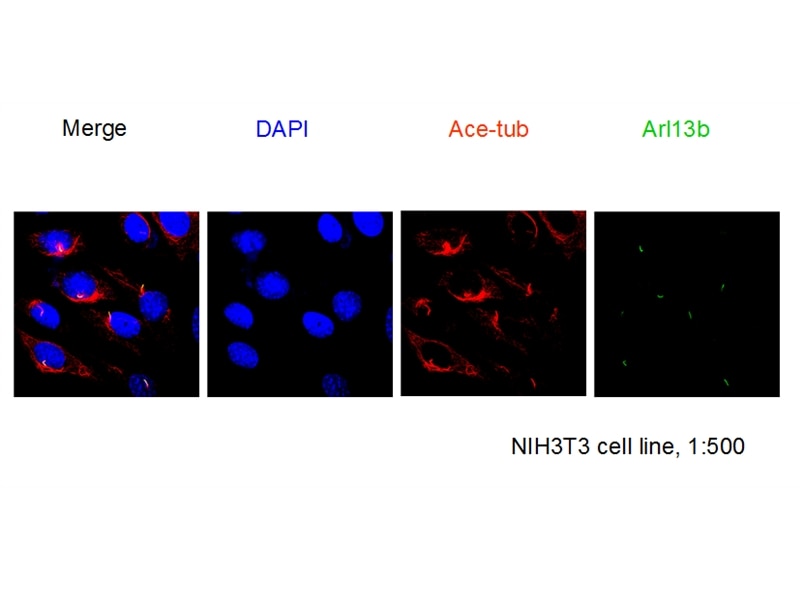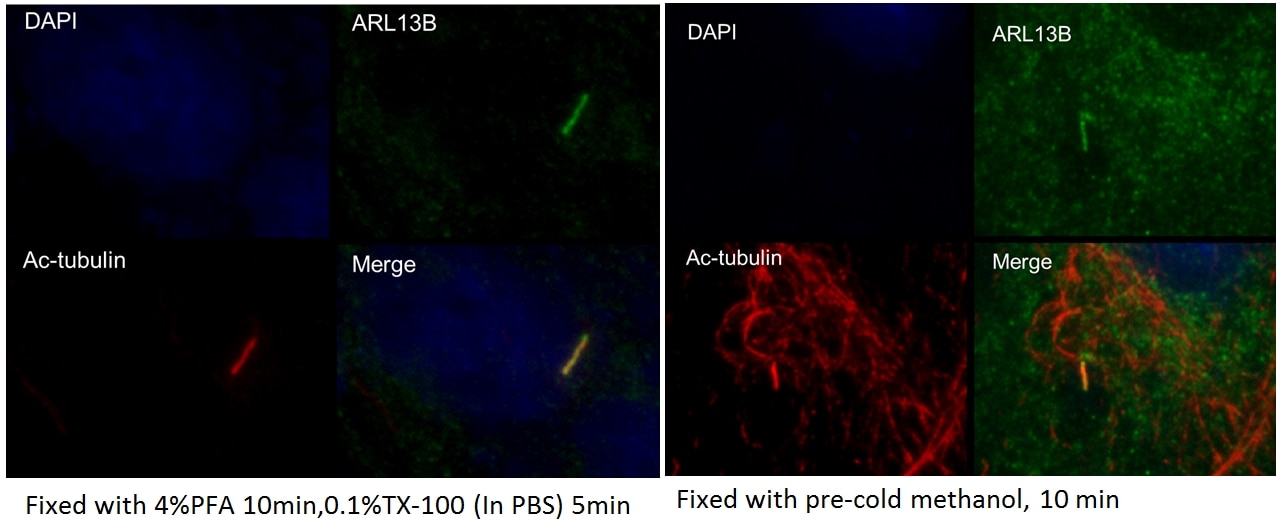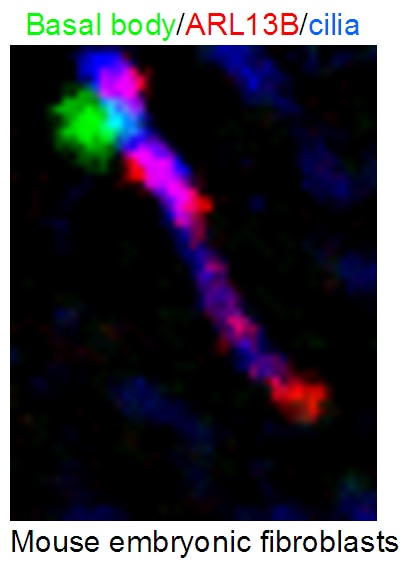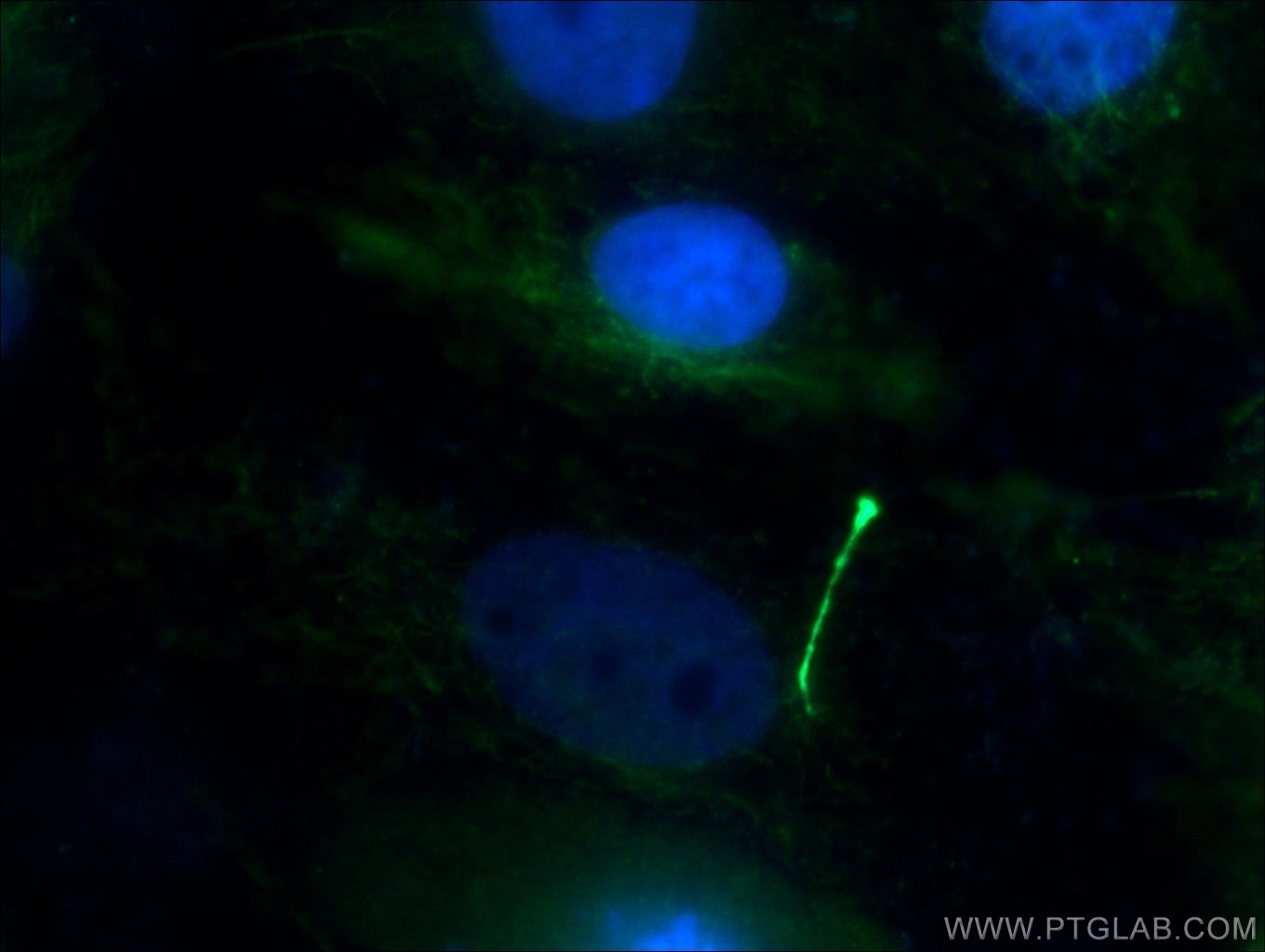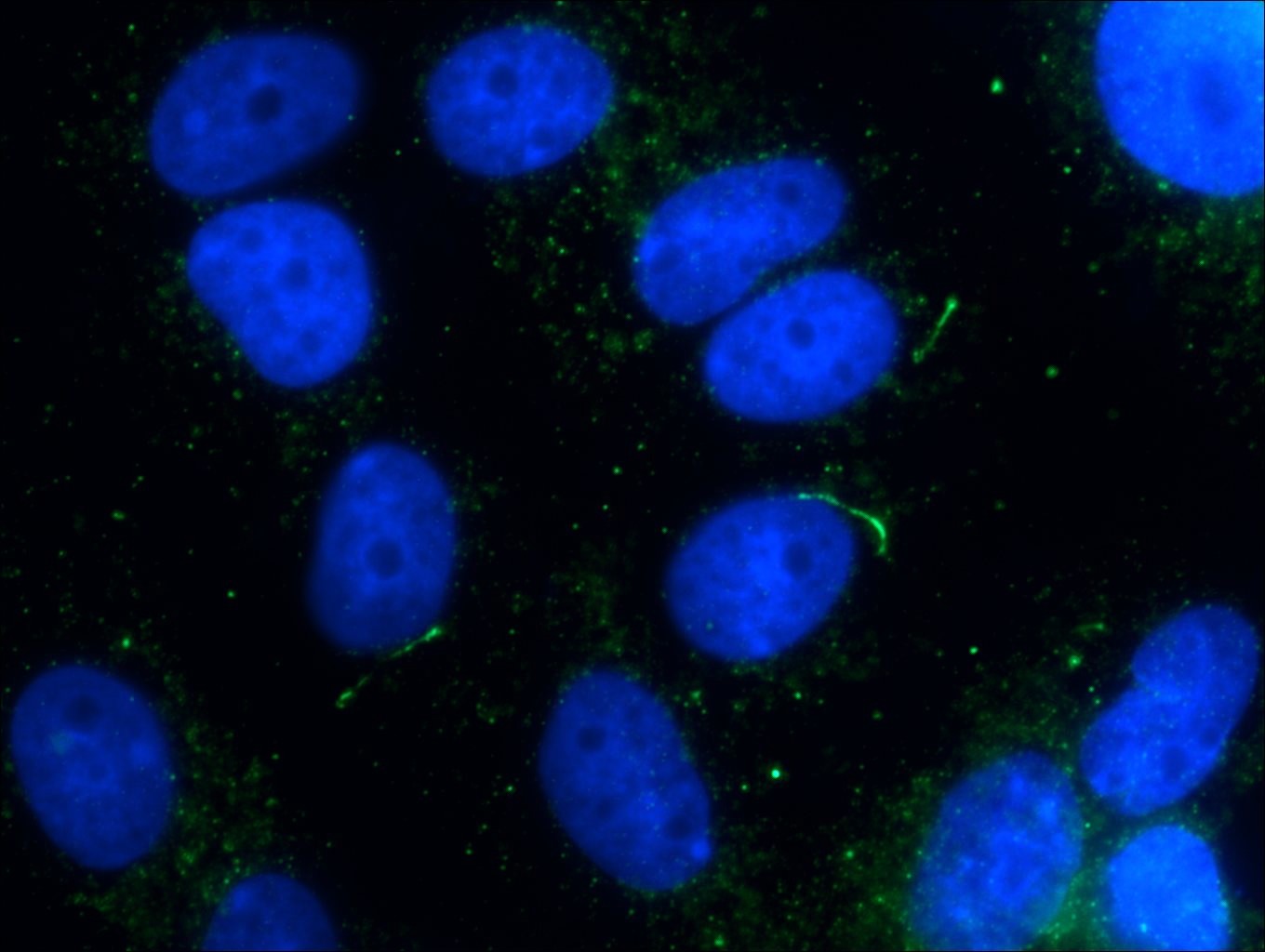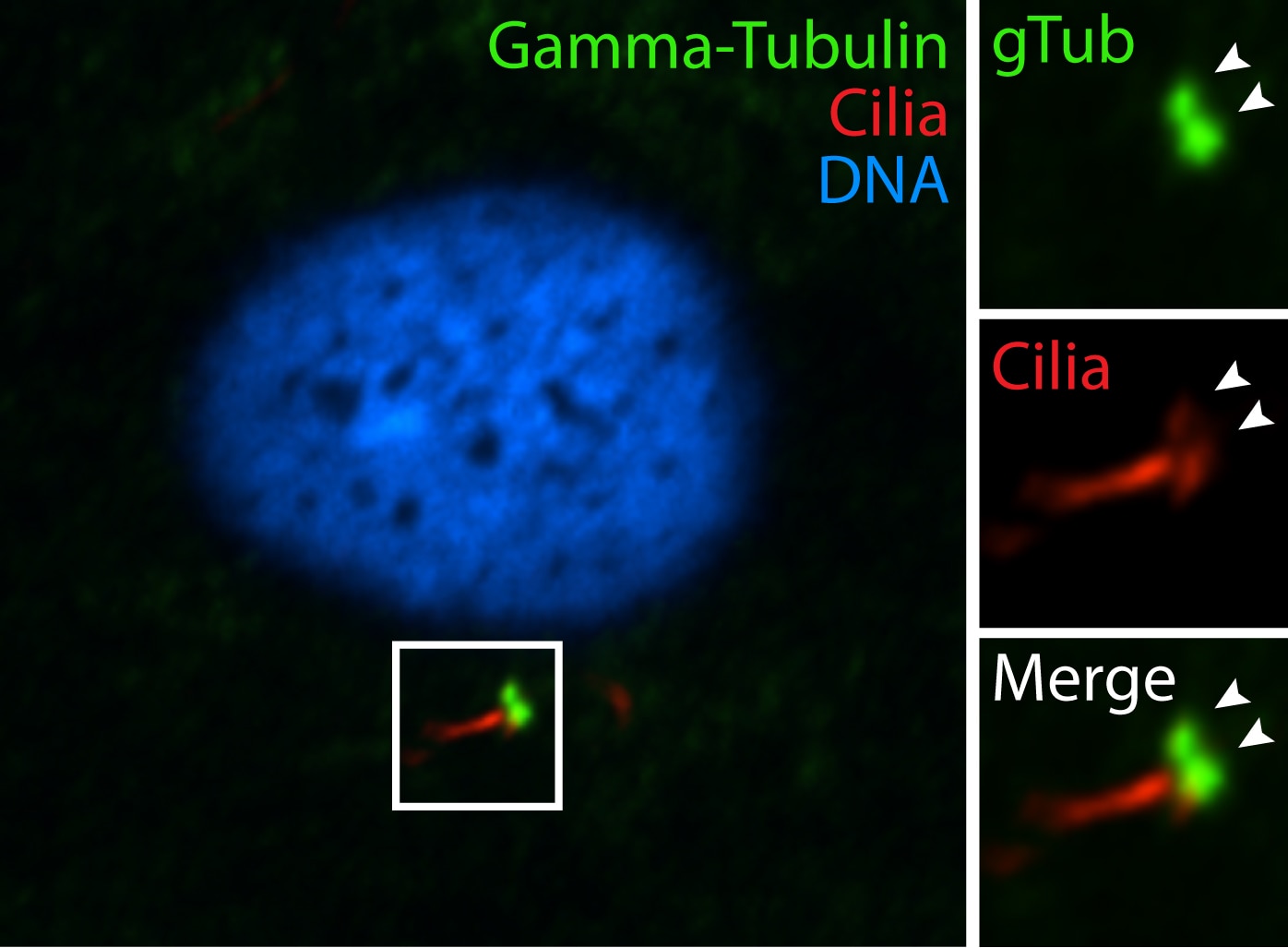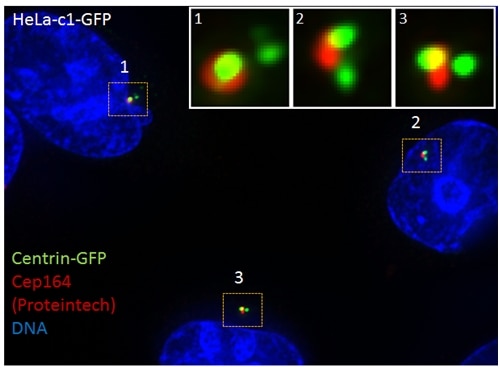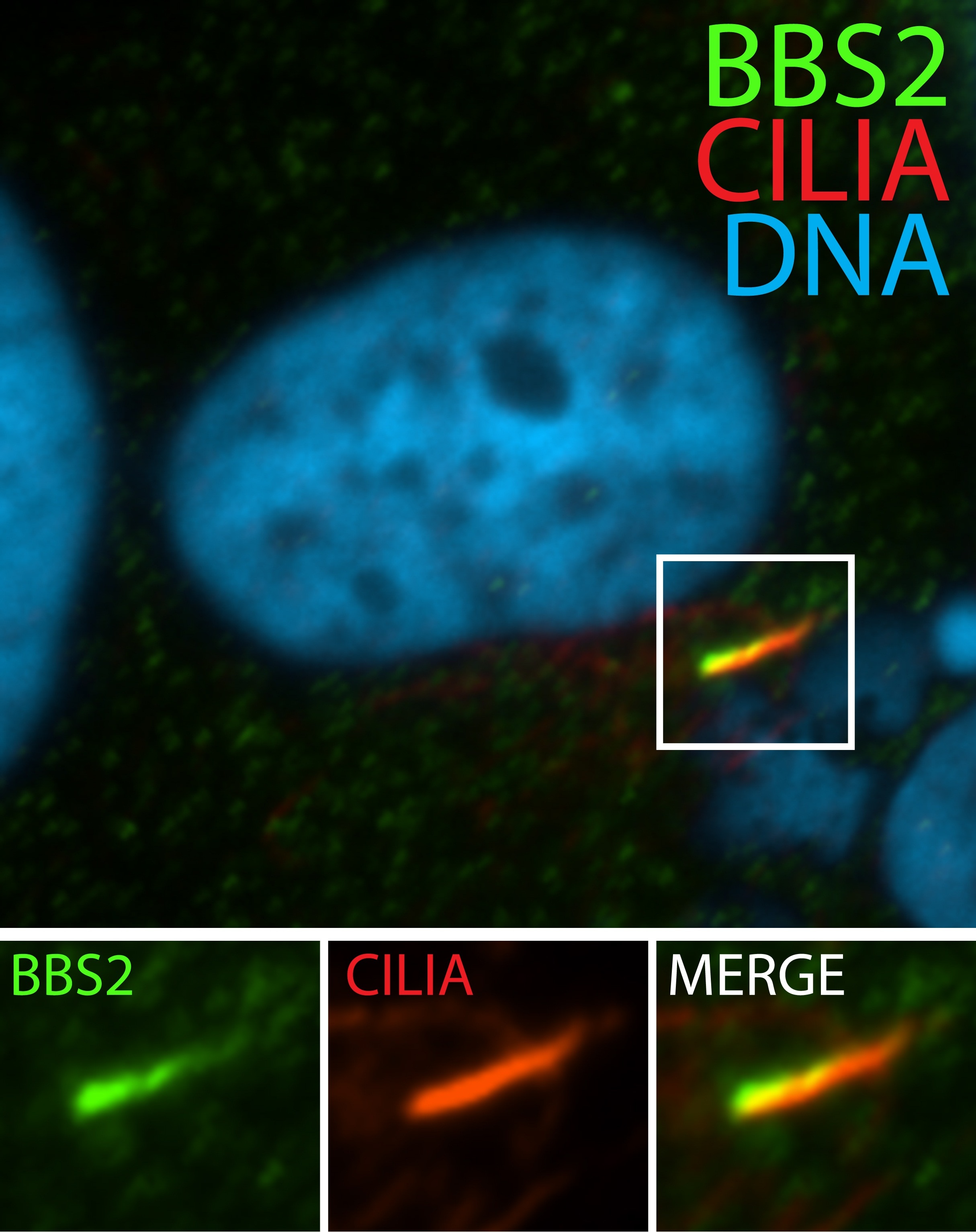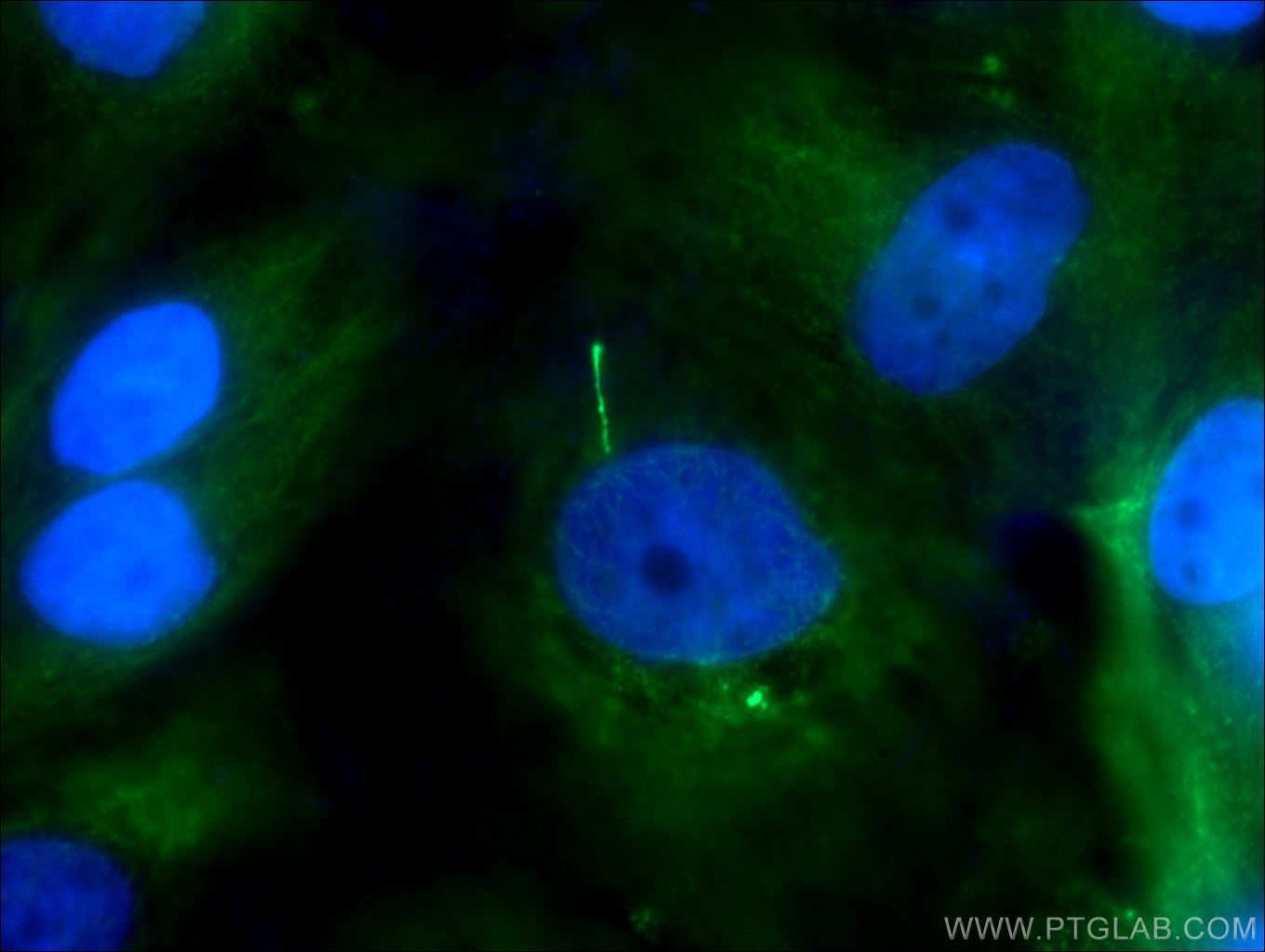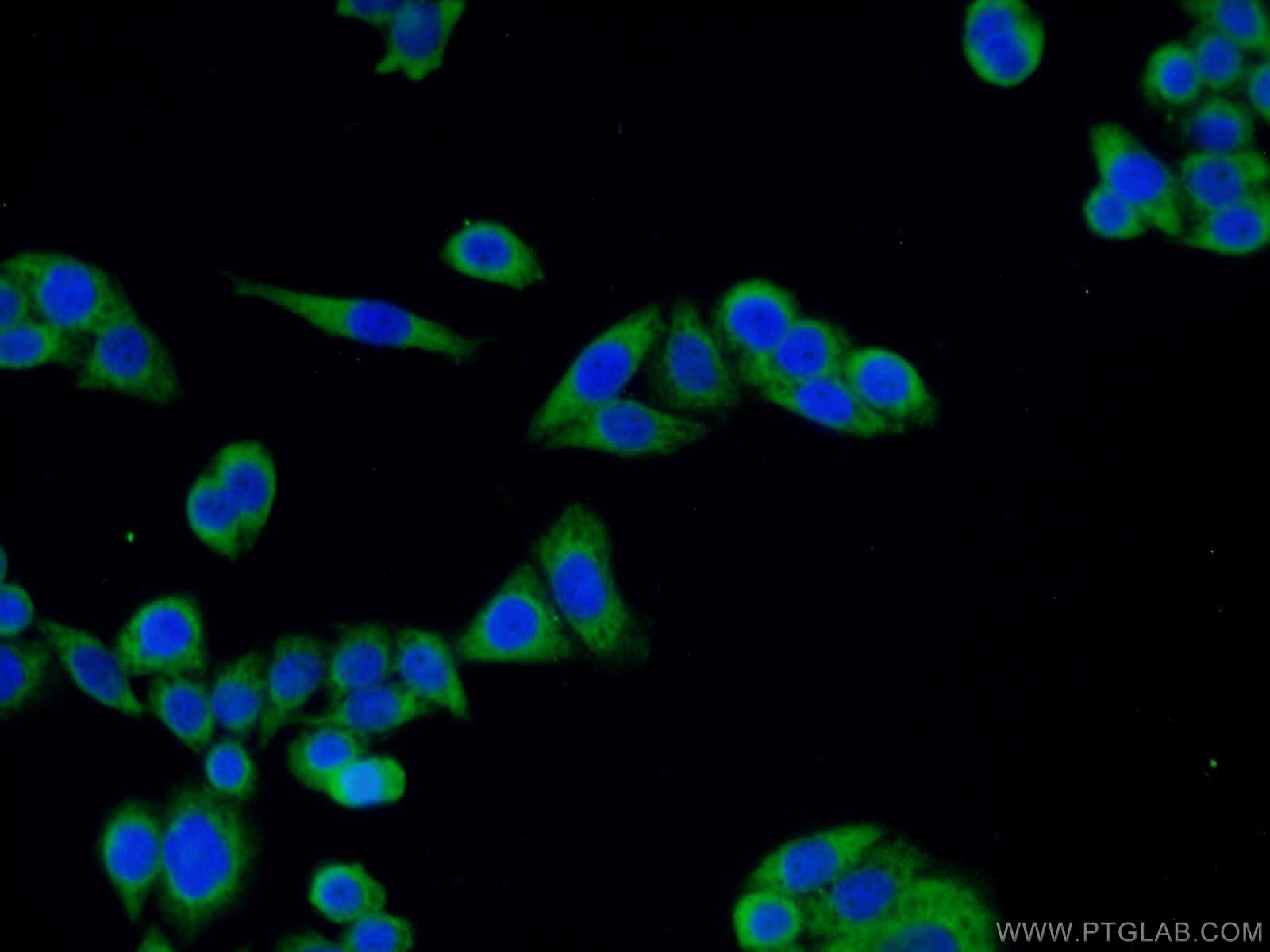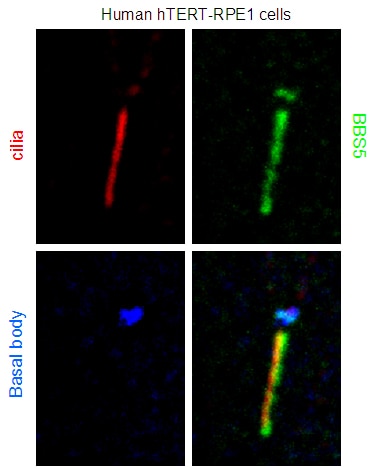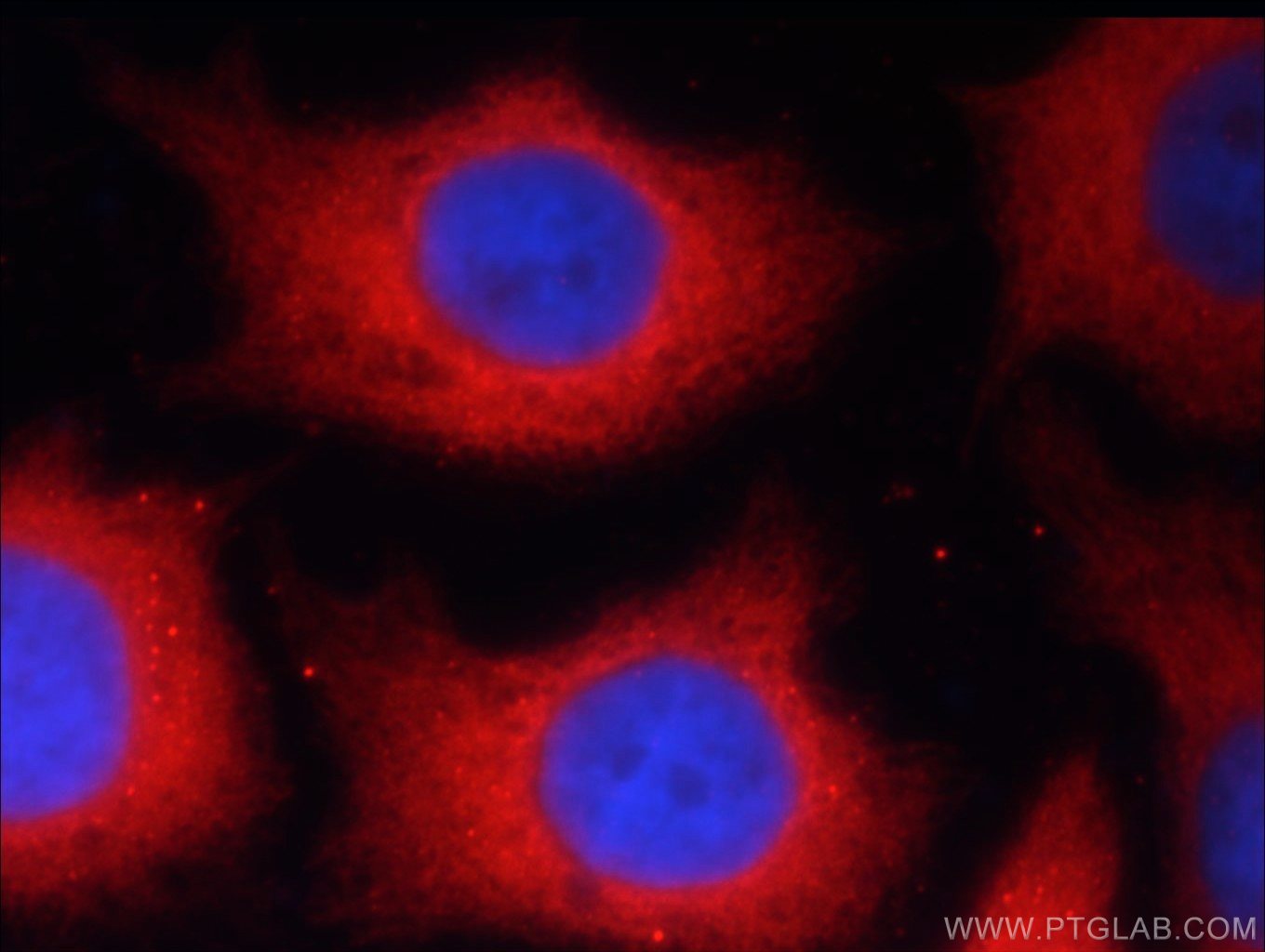- Phare
- Validé par KD/KO
Anticorps Polyclonal de lapin anti-ARL13B
ARL13B Polyclonal Antibody for WB, IP, IHC, ELISA, IF/ICC
Hôte / Isotype
Lapin / IgG
Réactivité testée
canin, Humain, rat, souris et plus (5)
Applications
WB, IHC, IF/ICC, IP, ELISA
Conjugaison
Non conjugué
750
N° de cat : 17711-1-AP
Synonymes
Galerie de données de validation
Applications testées
| Résultats positifs en WB | cellules L02, cellules NIH/3T3, tissu cérébral de souris, tissu hépatique de rat, tissu hépatique de souris, tissu rénal de rat, tissu rénal de souris |
| Résultats positifs en IP | cellules L02 |
| Résultats positifs en IHC | tissu cérébral de souris, tissu hépatique humain, tissu rénal humain, tissu testiculaire humain il est suggéré de démasquer l'antigène avec un tampon de TE buffer pH 9.0; (*) À défaut, 'le démasquage de l'antigène peut être 'effectué avec un tampon citrate pH 6,0. |
| Résultats positifs en IF/ICC | cellules MDCK, cellules hTERT-RPE1, cellules NIH3T3, fibroblastes embryonnaires de souris |
Dilution recommandée
| Application | Dilution |
|---|---|
| Western Blot (WB) | WB : 1:1000-1:6000 |
| Immunoprécipitation (IP) | IP : 0.5-4.0 ug for 1.0-3.0 mg of total protein lysate |
| Immunohistochimie (IHC) | IHC : 1:50-1:500 |
| Immunofluorescence (IF)/ICC | IF/ICC : 1:50-1:500 |
| It is recommended that this reagent should be titrated in each testing system to obtain optimal results. | |
| Sample-dependent, check data in validation data gallery | |
Informations sur le produit
17711-1-AP cible ARL13B dans les applications de WB, IHC, IF/ICC, IP, ELISA et montre une réactivité avec des échantillons canin, Humain, rat, souris
| Réactivité | canin, Humain, rat, souris |
| Réactivité citée | rat, canin, Humain, poisson-zèbre, porc, poulet, singe, souris, xénope |
| Hôte / Isotype | Lapin / IgG |
| Clonalité | Polyclonal |
| Type | Anticorps |
| Immunogène | ARL13B Protéine recombinante Ag12015 |
| Nom complet | ADP-ribosylation factor-like 13B |
| Masse moléculaire calculée | 48 kDa |
| Poids moléculaire observé | 40-48 kDa, 60 kDa |
| Numéro d’acquisition GenBank | BC094725 |
| Symbole du gène | ARL13B |
| Identification du gène (NCBI) | 200894 |
| Conjugaison | Non conjugué |
| Forme | Liquide |
| Méthode de purification | Purification par affinité contre l'antigène |
| Tampon de stockage | PBS avec azoture de sodium à 0,02 % et glycérol à 50 % pH 7,3 |
| Conditions de stockage | Stocker à -20°C. Stable pendant un an après l'expédition. L'aliquotage n'est pas nécessaire pour le stockage à -20oC Les 20ul contiennent 0,1% de BSA. |
Informations générales
ARL13B, also named as ARL2L1, is a small ciliary G protein of the Ras superfamily. Localized in the cilia, it is required for cilium biogenesis and sonic hedgehog signaling. Defects in ARL13B are the cause of Joubert syndrome (JS) which is an autosomal recessive disorder characterized by a distinctive cerebellar malformation (PMID: 19906870).This antibody detects two specific bands at 60 kDa and 48 kDa. Arl13b is predicted to be a 48 kDa protein, and the 60 kDa band is likely to represent a modified form of Arl13b. ARL13B can be used to mark the cilia (PMID:22072986).
Protocole
| Product Specific Protocols | |
|---|---|
| WB protocol for ARL13B antibody 17711-1-AP | Download protocol |
| IHC protocol for ARL13B antibody 17711-1-AP | Download protocol |
| IF protocol for ARL13B antibody 17711-1-AP | Download protocol |
| IP protocol for ARL13B antibody 17711-1-AP | Download protocol |
| Standard Protocols | |
|---|---|
| Click here to view our Standard Protocols |
Publications
| Species | Application | Title |
|---|---|---|
Nat Biotechnol Guided self-organization and cortical plate formation in human brain organoids. | ||
Nature Quantitative lineage analysis identifies a hepato-pancreato-biliary progenitor niche. | ||
Science Control of meiotic chromosomal bouquet and germ cell morphogenesis by the zygotene cilium. | ||
Nature A slow-cycling LGR5 tumour population mediates basal cell carcinoma relapse after therapy. | ||
Nature Aspm knockout ferret reveals an evolutionary mechanism governing cerebral cortical size. |
Avis
The reviews below have been submitted by verified Proteintech customers who received an incentive forproviding their feedback.
FH Ludovic (Verified Customer) (12-10-2023) | The perfect antibody, works each time!
|
FH Gagan (Verified Customer) (07-02-2023) | Antibody gives good staining for cilia.
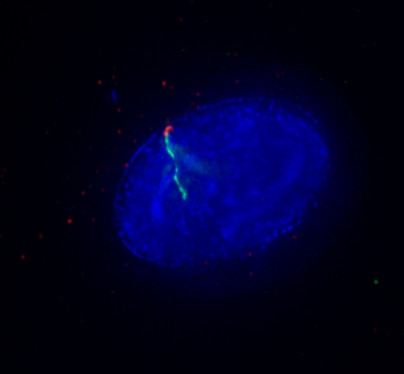 |
FH Mi (Verified Customer) (05-29-2023) | An excellent antibody, it works pretty well in human white adipocytes!
|
FH Elisa (Verified Customer) (03-17-2023) | Great antibody for centrosome and cilia visualizationin RPE1 cells. Cells were fixed in cold methanol for 10' at -20C, rehydrated with PBS for 5', and permeabilized with 0.1% Triton + 0.1% Tween +0.01%SDS in PBS for 5'. Cells were finally incubated with blocking buffer (5% BSA+ 0.1% Tween in PBS) for 30' at RT. Primary antibody was diluted in blocking buffer 1:200 and incubated for 1h at room temperature. Alexa-555-Anti-rabbit was used as secondary antibody (1:600 dilution) (1h at room temperature). Image show Arl13b (in magenta), DNA (Hoechst in blue) and g-tubulin (in green).
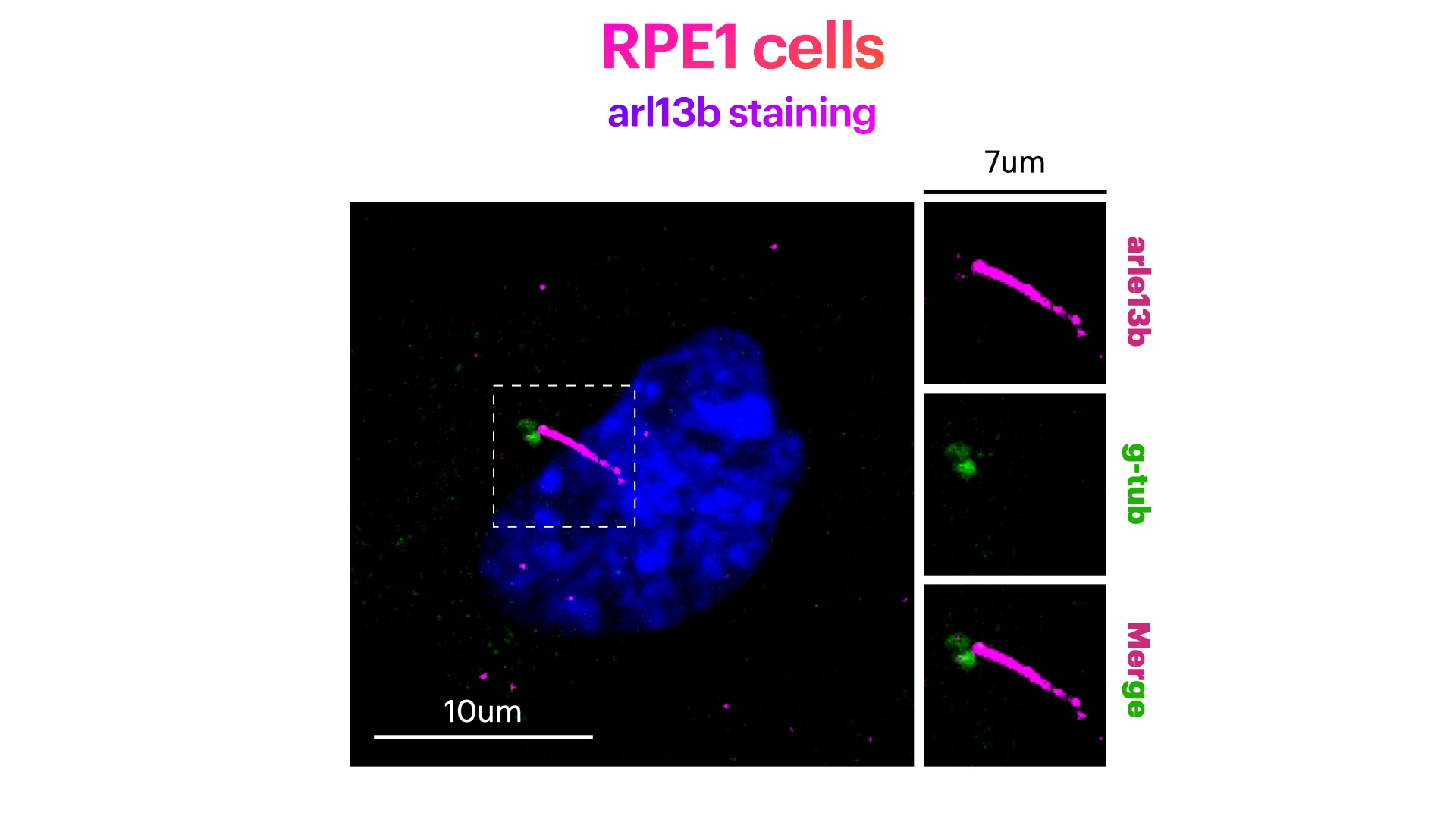 |
FH Serhiy (Verified Customer) (12-21-2022) | Excellent for immunofluorescent staining of ciliary Arl13b in mouse cells. Image shows ciliary axonemes immunostained for Arl13b (red).
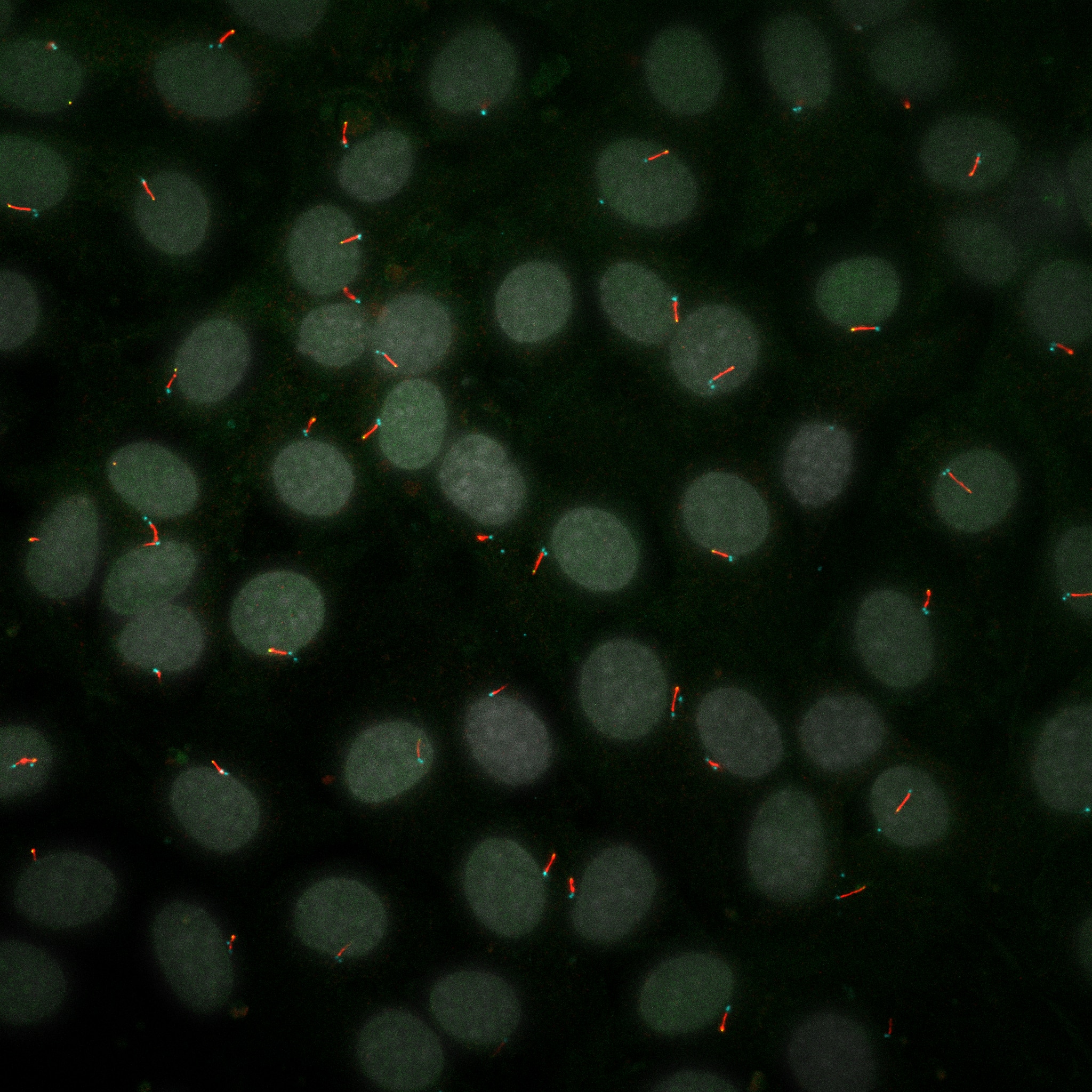 |
FH Kaviya (Verified Customer) (09-19-2022) | I use this antibody for IHC on brain tissue sections and it generally works well.
|
FH Charlotte (Verified Customer) (07-29-2022) | NIH-3T3 stained in DAPI (nucleus), FITC (gamma tubulin), Cy3 (Arl13b). The last picture is the merged channels (FITC and Cy3). On the merged channel, we can conclude that all Cy3 signal is validated by the FITC one (gamma tubulin is present at the base of the primary cilia). Perfect antibody !
 |
FH Sarah (Verified Customer) (02-16-2021) | Works beautifully in all cell types I've tried. Specifically great to see it work in primary cells (glioblastoma, pictured) as well as iPSCs
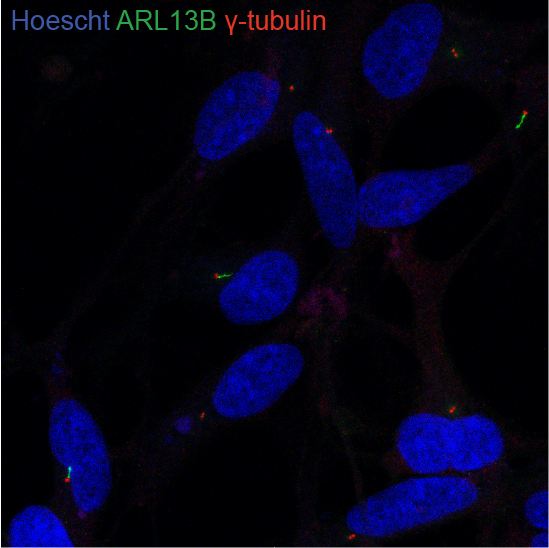 |
FH deng (Verified Customer) (01-30-2020) | Very good for cilia staining
 |
FH Gabriela (Verified Customer) (01-01-2020) | Very specific antibody for primary cilia. We use it in chicken embryos spinal cord.
|
FH KARTHIKEYAN (Verified Customer) (11-20-2019) | This antibody works really well in human and mouse cell lines and in zebrafish samples, we used this antibody for WB, IF and Flow cytometry.
 |
FH Rebeca (Verified Customer) (09-26-2019) | I have used this antibody for several immunofluorescence stainings of primary cilia. The antibody works beautifully, would definitely recommend!
|
FH Pavel (Verified Customer) (09-18-2019) | Strong ciliary staining in MDCK cells. Works both with PFA and MeOH fixation.
|
FH Lindsey (Verified Customer) (02-04-2019) | Excellent specificity with minimal background/nonspecific binding; This antibody is ideal because it works just as well in embryonic mouse tissue as it does in adult. I couldn't recommend this product more!
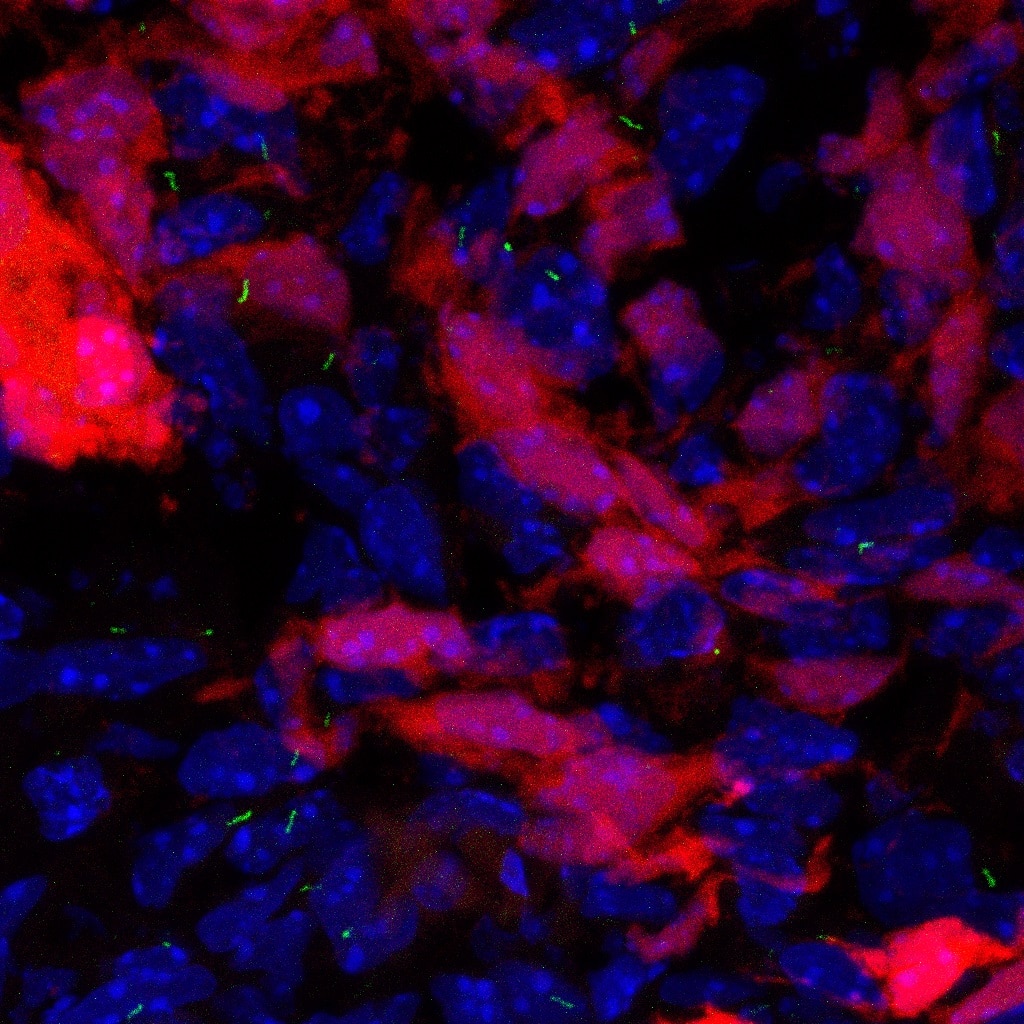 |
FH Kishor (Verified Customer) (01-30-2019) | I am very much satisfied with this produced, working good for WB (1:1000) and for IF (1:200)
|
